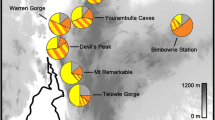Summary
The direction the lower mandible curves in crossbills (Loxia) is an example of a discrete polymorphism. The lower mandible crosses with equal frequency to the left and to the right in several crossbill populations. I hypothesize that the 1:1 ratio results from negative frequency-dependent selection favouring the rarer morph. A crossbill always orients toward closed conifer cones so that its lower mandible is directed towards the cone axis. Thus, only part of the cone can be reached easily when crossbills have few perch sites and the cone cannot be removed from the branch or otherwise turned round. Since crossbills may visit cones which have previously been foraged on by other individuals, an equal frequency of left-to-right mandible crossings may minimize overlap in the use of cones and enhance foraging efficiency. Experimental data support this hypothesis. Moreover, the variation in the ratio of mandible crossing directions among crossbill populations is consistent with this hypothesis.
Similar content being viewed by others
References
Benkman, C.W. (1987a) Food profitability and the foraging ecology of crossbills.Ecol. Monogr. 57 251–67.
Benkman, C.W. (1987b) Crossbill foraging behavior, bill structure, and patterns of food profitability.Wilson Bull 99 351–68.
Benkman, C.W. (1988a) A 3: 1 ratio of mandible crossing direction in White-winged Crossbills.Auk 105 578–9.
Benkman, C.W. (1988b) On the advantages of crossed mandibles: an experimental approach.Ibis 129 288–93.
Benkman, C.W. (1989a) Intake rate maximization and the foraging behaviour of crossbills.Ornis Scand. 20 65–8.
Benkman, C.W. (1989b) On the evolution and ecology of island populations of crossbills.Evolution 43 1324–30.
Benkman, C.W. (1992) White-winged Crossbills. InThe birds of North America (A. Poole, P. Stettenheim, and F. Gill, eds), pp. 1–18. The Academy of Natural Sciences of Philadelphia. Philadelphia, PA.
Benkman, C.W. (1993) Adaptation to single resources and the evolution of crossbill (Loxia) diversity.Ecol. Monogr. 63 305–25.
Benkman, C.W. (1994) Comments on the ecology and status of the Hispaniolan crossbill (Loxia leucoptera megaplaga), with recommendations for its conservation.Caribb. J. Sci. 30 250–4.
Benkman, C.W. and Lindholm, A.K. (1991) The advantages and evolution of a morphological novelty.Nature 349 519–20.
Benkman, C.W., and Miller, R.E. (1996) Morphological evolution in response to fluctuating selection pressures. Manuscript submitted to Am. Nat.
Génard, M. and Lescourret, F. (1987) The Common CrossbillLoxia curvirostra in the Pyrenees: some observations on its habitats and on its relations with conifer seeds.Bird Study 34 52–63.
Groth, J.G. (1992) Further information on genetics of bill crossing in crossbills.Auk 109 389–5.
Groth, J.G. (1993)Evolutionary Differentiation in Morphology, Vocalizations, and Allozymes among Nomadic Sibling Species in the North American Red Crossbill (Loxia curvirostra) Complex.Univ. Calif. Publ. Zool., University of California Press, Berkeley, CA, USA.
Hori, M. (1993) Frequency-dependent natural selection in the handedness of scale-eating cichlid fish.Science 260 216–19.
James, P.C., Barry, T.W., Smith, A.R. and Barry, S.J. (1987) Bill crossover ratios in Canadian crossbillsLoxia spp.Ornis Scand. 18 310–12.
Knox, A.G. (1983) Handedness in crossbillsLoxia and the AkepaLoxops coccinea.Bull. Br. Ornithol. Club 103 114–18.
Maynard Smith, J. (1982)Evolution and the Theory of Games. Cambridge University Press, Cambridge, UK.
Milinski, M. and Parker, G.A. (1991) Competition for resources. InBehavioral ecology (J.R. Krebs and N.B. Davies, eds), pp. 137–68. Blackwell, Oxford.
Moreton, B.D. (1936) Crossbills' method of feeding on larch cones.Br. Birds 30 27–8.
Newton, I. (1972)Finches. Collins, London.
Schuster, S.M. and Wade, M.J. (1991) Equal mating success among male reproductive strategies in a marine isopod.Nature 350 608–10.
Senar, J.C., Borras, A., Cabrera, T. and Cabrera, J. (1993) Testing for the relationship between coniferous crop stability and Common Crossbill residence.J. Field Ornithol. 64 464–9.
Takahashi, S. and Hori, M. (1994) Unstable evolutionarily stable strategy and oscillation: a model of lateral asymmetry in scale-eating cichlids.Am. Nat. 144 1001–20.
Ticehurst, C.B. (1910) Dimorphism in the crossbill.Br. Birds 3 261–2.
Tordoff, H.B. (1954) Social organization and behavior in a flock of captive, nonbreeding Red Crossbills.Condor 56 346–58.
Webb, T., III (1988) Eastern North America. InVegetation history, Handbook of vegetation science, Vol. 7 (B. Huntley and T. Webb, III, eds), pp. 385–414. Kluwer Academic Publishers, Boston.
Author information
Authors and Affiliations
Rights and permissions
About this article
Cite this article
Benkman, C.W. Are the ratios of bill crossing morphs in crossbills the result of frequency-dependent selection?. Evol Ecol 10, 119–126 (1996). https://doi.org/10.1007/BF01239352
Issue Date:
DOI: https://doi.org/10.1007/BF01239352




